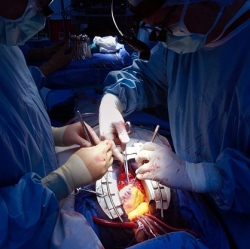
Soon the days of large, battery-powered implants like a pacemaker may be a thing of the past. A team of engineers at Stanford has delivered a proof-of-concept device that was small enough to propel itself through the blood stream, demonstrating the ability to power micro-devices wirelessly.
This eliminates the batteries — and the repeated surgeries to replace them.
The tiny test device — a 1.6-millimeter-wide cube (roughly the size of a head of a pin) — used inductive and radiative transmission of power, which essentially means a transmitter sent radio waves to a coil of wire inside the body that powers the implant. So why haven’t we gone wireless in medicine before now?
The problem was the size. The smaller the receiving coil inside the body, the higher the frequency needs to be to reach it and prevailing mathematical models indicated such high frequencies couldn’t penetrate the five centimeters of human tissue needed to get to the heart.
Stanford assistant professor of electrical engineering Ada Poon and her team tackled the modeling again and found that high frequency signals can actually travel further than they had believed. After revising the models, they found that a 1.7 gigahertz signal penetrates living human tissue much deeper than low frequency signals. This allowed for an amazing tenfold increase in power transfer, while at the same time allowing the internal antenna ten times smaller.
The team says that at the optimal frequency, a millimeter radius coil (roughly the size of the head of a pin) can generate more than 50 microwatts of power. Considering that recently demonstrated pacemakers require just eight microwatts and you can begin to see the possibilities.
